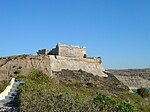Serra d'El-Rei
Freguesias of Peniche, PortugalLeiria geography stubsTowns in Portugal

Serra d'El-Rei ('Mountains of the King') is a Portuguese parish in the municipality of Peniche on the Atlantic Coast. The population in 2011 was 1,401, in an area of 8.92 km². Serra d'El-Rei became a town on July 1, 2003. It was at Serra d'El-Rei that King Peter I of Portugal lived with his lover Inês de Castro. His 14th-century castle in the town is now divided into three private living houses today. Serra d'El-Rei is 7 km (4.3 mi) west of the historic walled-town of Óbidos, and 10 km east from Peniche.
Excerpt from the Wikipedia article Serra d'El-Rei (License: CC BY-SA 3.0, Authors, Images).Serra d'El-Rei
Rua do Poço Novo, Peniche
Geographical coordinates (GPS) Address Nearby Places Show on map
Geographical coordinates (GPS)
| Latitude | Longitude |
|---|---|
| N 39.331 ° | E -9.27 ° |
Address
Rua do Poço Novo
Rua do Poço Novo
2525-801 Peniche
Portugal
Open on Google Maps



